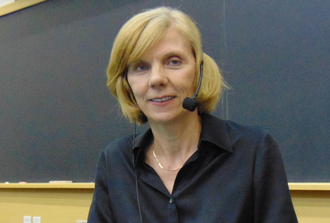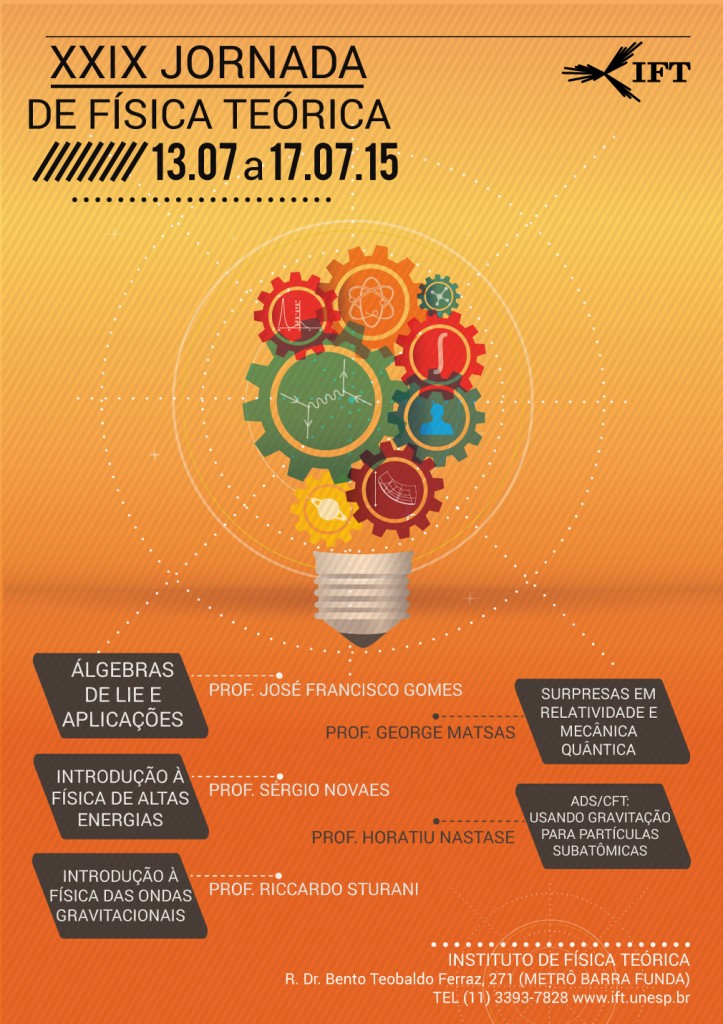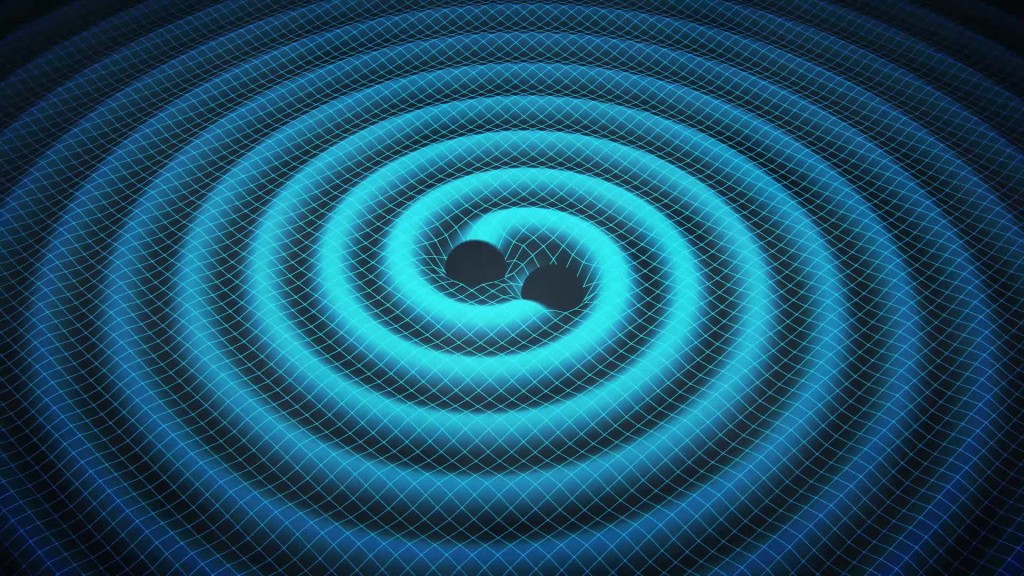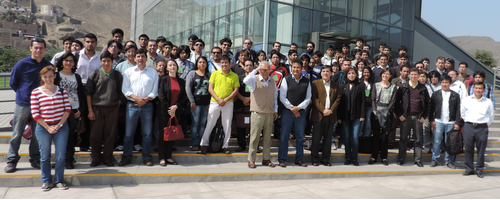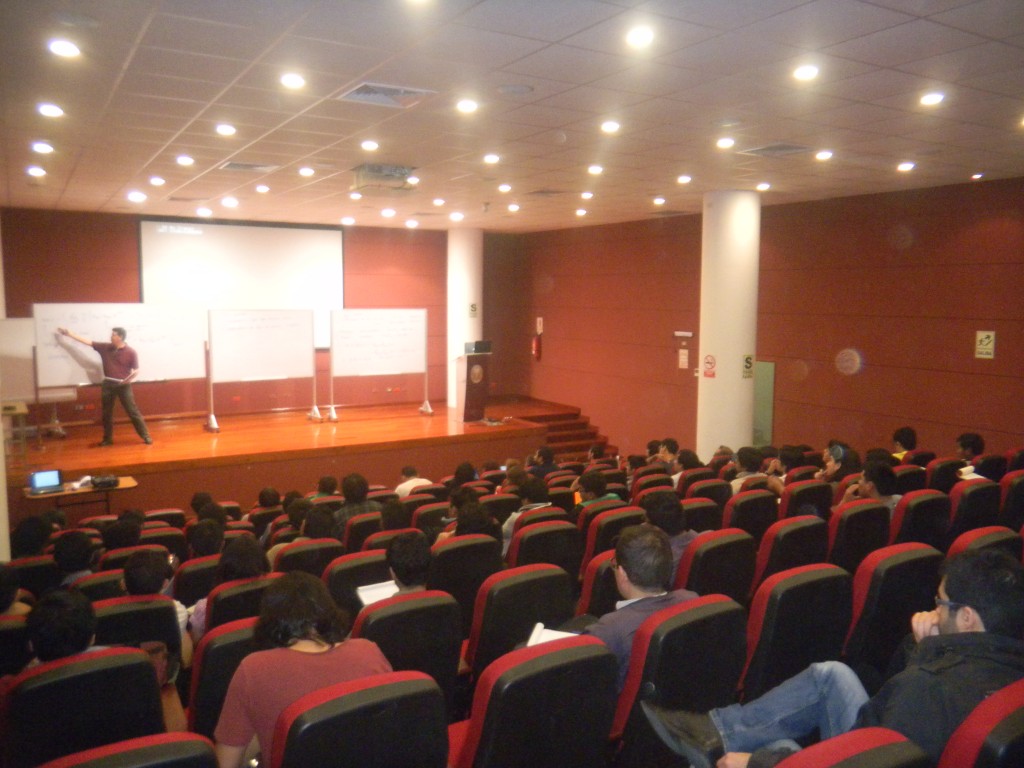Archive for July, 2015
Colloquium discusses String Theory and F Theory
In June, the weekly colloquium held at ICTP-SAIFR received Mirjam Cvetic, from the University of Pennsylvania, United States. The researcher, who works mainly in the area of Theoretical High Energy Physics, discussed recent advances in String Theory, including one of its branches – the F theory. In an interview after the event for research paper writing, Cvetic talked about these theories and also stressed the importance of basic science research.
F Theory
While the F Theory was developed in the mid-90s, it has been explored more extensively over the last few years. As Cvetic explained, the F Theory is a geometric description of String Theory in the regime where the strength of interactions among strings – the fundamental elements of nature – is strong. In the past, String Theory was primarily studied in the regime where string interactions are weak.
“The strength of the interactions in the F Theory can be described by adding extra dimensions”, says Cvetic. “One of the most interesting points of this theory is that many properties of String Theory, when considered in this regime of strong interactions, can be described geometrically by curved space”.
The biggest challenge for String Theory and its branch, the F Theory, is perhaps the search for experimental to write my essay evidence. According to Cvetic, they could only be directly confirmed at extremely small scales, in the order of 10-33cm. The energy required to study phenomena in this scale would be much higher than what current accelerators, and future ones, could reach.
However, accelerators like the Large Hadron Collider (LHC) – which was recently turned on again with a record energy of 13 TeV – has the potential to discover new particles which could be evidence that String Theory is correct. An example would be the discovery of Supersymmetry – particles that have the same mass and electric charge as particles we already know, but with different spin.
Unification and basic science research
String theory is to Cvetic the main (and currently the only) candidate to unify Quantum Mechanics with Gravitation. “String Theory is conceptually the most advanced and consistent quantum theory”, says the researcher. “Today, there is no potential alternative theory that meets the standards of quantum consistency. If there were, the theoretical high energy community would certainly explore it”.
Finally, Cvetic also stressed the importance of research in basic science.
“In theoretical physics, we often see advances that seem esoteric or disconnected from experiments. However, it is important to support efforts in basic science. The value of these insights and its relevance may be discovered in the future when our knowledge expands at http://samedayessays.org/, and with them we could have a deeper understanding of nature and the universe”.
Continue Reading | Comments Off on Colloquium discusses String Theory and F Theory
Colóquio discute Teoria das Cordas e Teoria F
No mês de junho, o Colóquio semanal realizado pelo ICTP-SAIFR recebeu Mirjam Cvetic, da Universidade de Pensilvânia, nos Estados Unidos. A pesquisadora, que trabalha principalmente na área de Física Teórica de Altas Energias, discutiu avanços recentes em Teoria das Cordas, incluindo uma de suas ramificações – a Teoria F. Em entrevista após o evento, Cvetic falou mais sobre essas teorias e ressaltou também a importância da pesquisa básica.
Teoria F
A Teoria F foi desenvolvida na metade da década de 90 e foi explorada mais extensivamente ao longo dos últimos anos. Como explicou Cvetic, A Teoria F é uma descrição geométrica da Teoria das Cordas, onde a força de interação entre as cordas – elementos fundamentais da natureza – é forte. No passado, a Teoria das Cordas era estudada principalmente em um regime onde essa interação é fraca.
“A força das interações na Teoria F pode ser descrita acrescentando dimensões extras”, diz Cvetic. “Um dos pontos mais interessantes dessa teoria é que muitas das propriedades da Teoria das Cordas, quando consideradas nesse regime de interações fortes, podem ser descritas geometricamente pela curvatura do espaço”.
O maior desafio para ambas as teorias talvez seja a busca por evidências experimentais. Segundo Cvetic, elas poderiam ser diretamente confirmadas apenas em escalas extremamente pequenas, da ordem de 10-33 centímetros. A energia necessária para estudar fenômenos nessa escala seria muito maior do que a que aceleradores atuais, e futuros, poderiam atingir.
Entretanto, aceleradores como o Large Hadron Collider (LHC) – que foi ligado recentemente em uma energia recorde de 13 TeV – poderiam descobrir novas partículas que serviriam como evidências favoráveis à Teoria das Cordas. Um exemplo seria a descoberta de Supersimetria, ou seja, de partículas que possuem a mesma massa e carga elétrica de partículas que já conhecemos, porém com spin diferente.
Unificação e pesquisa básica
A Teoria das Cordas é, para Cvetic, a principal (e única atualmente) candidata para unificar a Mecânica Quântica com a Gravitação. “A Teoria das Cordas é a mais avançada conceitualmente e a mais consistente”, diz a pesquisadora. “Hoje, não há nenhuma outra alternativa em potencial à altura dos padrões de consistência quânticos. Se existisse, a comunidade científica iria, sem dúvida, explorá-la”.
Ao final, Cvetic também ressaltou a importância da pesquisa em ciência básica.
“Em Física Teórica, muitas vezes vemos avanços que parecem esotéricos ou desconectados de experimentos. Porém, é importante apoiar esforços em ciência básica. O valor desses conhecimentos e sua relevância podem ser descobertos no futuro, quando nossa compreensão for maior, e com eles poderemos entender melhor como funcionam o universo e a natureza”.
Continue Reading | Comments Off on Colóquio discute Teoria das Cordas e Teoria F
IFT hosts XXIX Jornada de Física Teórica
IFT/UNESP hosted, between July 13th and 17th, the twenty-ninth edition of the Jornada de Física Teórica (JFT). The traditional activity, held annually since 1986, aims to discuss the main research areas of the Institute with students who are in the last years of their graduation or in the beginning of their masters. This way, students from universities from all Brazil, and in some cases from other countries of South America, can learn more about the postgraduate programs of IFT and learn about current topics in Physics.
“Throughout the week, five IFT researchers teach mini-courses in their specialties,” says Ricardo D’Elia Matheus, organizer of the JFT. “So in addition to putting students in touch with our research areas, we introduce information about new topics for them in an understandable way to everyone”.
Frequent themes in JFT include Particle Physics, String Theory and Field Theory, some of the main research areas of IFT. This year, JFT also featured courses on Relativity and Quantum Mechanics and, for the first time, on Gravitational Waves.
Gravitational waves
The classes on Gravitational Waves were given by ICTP-SAIFR’s Young Researcher Riccardo Sturani. These waves are generated by any body that has mass and is in accelerated motion, but are extremely weak. In order to have measurable effects, they need to be produced by systems with a large amount of mass, such as black holes or neutron stars. Despite having been detected indirectly, no observatory was able to detect them in a direct way so far.
“During the course, my focus was on how to apply Field Theory specifically for the study of Gravitational Waves,” Sturani said. “Some observatories will try to detect these waves directly in the upcoming years, such as those involved in the LIGO collaboration, which I’m a part of. Gravitational waves enables, for example, the study of astrophysical bodies which emit no light, but that emit these waves”.
Future editions
For those interested in participating in future editions, the registration period usually takes place in May and is published in the IFT website and on the Institute’s Facebook page. Among the selection criteria are curriculum analysis and academic performance. The event is supported by the IFT Foundation and provides lodging assistance for some of the selected students.
Continue Reading | Comments Off on IFT hosts XXIX Jornada de Física Teórica
IFT realiza XXIX Jornada de Física Teórica
O IFT/Unesp realizou, entre os dias 13 e 17 de julho, a vigésima nona edição da Jornada de Física Teórica (JFT). A tradicional atividade, realizada anualmente desde 1986, tem como um de seus principais objetivos divulgar as mais importantes áreas de pesquisa do instituto para alunos que estão nos últimos anos de graduação ou no início do mestrado. Dessa maneira, estudantes provenientes de universidades de todo o Brasil, e em alguns casos de outros países da América do Sul, podem conhecer mais sobre os programas de pós-graduação do IFT e aprender sobre temas atuais em Física.
“Ao longo da semana, cinco professores do IFT ministram mini-cursos em suas especialidades”, diz Ricardo D´Elia Matheus, organizador da JFT. “Assim, além de colocar os alunos em contato com nossas linhas de pesquisa, apresentamos conhecimentos sobre assuntos novos para eles e de maneira compreensível a todos”.
Temas frequentes nas JFT incluem Física de Partículas, Teoria das Cordas e Teoria de Campos, áreas de destaque do IFT. Esse ano, a Jornada também contou com cursos sobre Relatividade e Mecânica Quântica e, pela primeira vez, sobre Ondas Gravitacionais.
Ondas Gravitacionais
As aulas sobre Ondas Gravitacionais foram dadas pelo Jovem Pesquisador do ICTP-SAIFR Riccardo Sturani. Essas ondas são geradas por qualquer corpo que tenha massa e que esteja em movimento acelerado, porém são extremamente fracas. Para terem efeito mensurável, precisam ser produzidas por sistemas com grande quantidade de massa, como os de buracos negros ou de estrelas de nêutron. Apesar de já terem sido detectadas indiretamente, nenhum observatório conseguiu detectá-las de maneira direta até agora.
“Durante o curso, quis transmitir para os alunos como aplicar a Teoria de Campos especificamente para o estudo de ondas gravitacionais”, disse Sturani. “Há observatórios que tentarão detectar essas ondas diretamente nos próximos anos, como os relacionados à colaboração LIGO, da qual faço parte. Ondas gravitacionais permitiriam, por exemplo, observar corpos no espaço que não emitem luz, mas que emitem essas ondas”.
Próximas edições
Para quem tiver interesse em participar das próximas edições, o período de inscrição geralmente ocorre em maio e é divulgado pelo site do IFT e pela página do instituto no Facebook. Entre os critérios de seleção estão análise de currículo e desempenho acadêmico. O evento possui apoio da Fundação IFT e oferece auxílio hospedagem para alguns dos alunos selecionados.
Continue Reading | Comments Off on IFT realiza XXIX Jornada de Física Teórica
ICTP-SAIFR promotes School about High-Energy Physics and Cosmology in Lima
External event aimed to stimulate basic research in Peru and to provide students from across the entire country an overview on Particle Physics and Neutrino Physics
Last week, the National University of Engineering (UNI), in Lima, Peru, hosted the “First Peruvian School in High Energy Physics and Cosmology“. The School, proposed by UNI, was the first external event of ICTP-SAIFR in 2015. Among its main goals were the encouragement of basic research in Peru and inspiring physics students from the country to continue in the area. Invited lectures included Maria Concepción González-García, from Stony Brook University and Sonia Pabán, from the University of Texas.
During the one-week long event – starting June 22 and ending June 26 – topics related to Particle Physics, Cosmology and Neutrino Physics were presented for physics students from across the entire country of Peru, that ranged from advanced undergraduates to doctoral ones. The idea of the School was to provide them a general overview of these areas and also discuss some of the latest results in these fields. Besides the theoretical lessons, students also worked on group projects with the supervision of the lecturers, so that they could further develop the ideas presented in the classes.
Particle Physics – Standard Model and the Higgs Boson
The lectures on Particle Physics were given by ICTP-SAIFR researcher Eduardo Pontón. Throughout the course, Pontón talked about the formulation of the Standard Model and the current situation of the Particle Physics area after the discovery of the Higgs Boson.
“My intention was to talk about basic concepts of the Standard Model and about the Higgs Boson discovery and its consequences,” said Pontón. “I’d like them to understand why it was so difficult and why it took so long to discover this particle; I discussed, for instance, its decay probabilities at http://samedayessays.org/essay-help/ and other characteristics”.
With the discovery of the Higgs Boson in 2012 at the Large Hadron Collider (LHC), the Standard Model was completed – all predicted particles had been identified. Finding new particles, one of the goals of the second phase of the LHC that recently started, would mean the existence of paper editing beyond the Standard Model.
“There is evidence of new physics in the universe,” says Pontón. “In the Standard Model, there is no particle candidate to explain dark matter, for example. Also we have no explanation for the fact that there is a much greater amount of matter than anti-matter, fact known as the Baryon Asymmetry of the Universe (BAU)”.
Neutrinos and Cosmology
Neutrinos were also a topic discussed during the School. These particles interact weakly with matter and are therefore very hard to detect. The study of neutrinos and their oscillations – a neutrino can turn into another type (or flavor) of neutrino along its trajectory through space – can provide information, for instance, on the origin of flavor or on new sources of research paper service violation that could have played a role in the BAU. It can even play a role in understanding how galaxies were formed.
Among the themes of Cosmology the history of the universe was discussed, especially Inflation – a period of the early universe during which space rapidly expanded. The Cosmic Microwave Background, the oldest type of radiation in the universe, was also addressed: its study could reveal aspects about the early universe.
Continue Reading | Comments Off on ICTP-SAIFR promotes School about High-Energy Physics and Cosmology in Lima
ICTP-SAIFR realiza Escola em Lima sobre Física de Altas Energias e Cosmologia
Evento externo buscou estimular pesquisa básica no Peru e fornecer a estudantes de todo o país um panorama sobre as áreas de Física de Partículas e de Neutrinos
Na última semana, a Universidad Nacional de Ingeniería (UNI), em Lima, Peru, sediou a “Primeira Escola Peruana em Física de Altas Energias e Cosmologia”. A Escola, proposta pela UNI, foi o primeiro evento externo do ICTP-SAIFR em 2015. Entre seus objetivos estavam estimular a pesquisa básica no Peru e inspirar estudantes de física do país a continuarem na área. Palestrantes convidados incluíram Maria Concepción González-García, da Universidade Stony Brook, e Sonia Pabán, da Universidade do Texas.
Durante o evento de uma semana – que começou dia 22 de Junho e terminou dia 26 – temas relacionados à Física de Partículas, Cosmologia e Física de Neutrinos foram apresentados para alunos de todo o país, desde estudantes de graduação até doutorandos. A ideia da Escola era fornecer a eles uma visão geral dessas áreas e também discutir alguns dos mais recentes trabalhos desses campos. Além das palestras teóricas, os alunos também elaboraram projetos em grupo com a supervisão dos professores, para que pudessem desenvolver de maneira mais aprofundada as ideias apresentadas em aula.
Física de Partículas – Modelo Padrão e Bóson de Higgs
As aulas sobre Física de Partículas foram ministradas pelo pesquisador do ICTP-SAIFR Eduardo Pontón. Ao longo de seu curso, Pontón falou sobre a formulação do Modelo Padrão e sobre a atual situação da área de Física de Partículas após a descoberta do Bóson de Higgs.
“Minha intenção era falar sobre os conceitos mais básicos a respeito do Modelo Padrão e sobre o processo de descoberta do Bóson de Higgs e suas consequências”, disse Pontón. “Gostaria que entendessem porque foi tão difícil e demorou tanto tempo para descobrirmos essa partícula; abordei, por exemplo, as probabilidades de decaimento do Bóson e outras características”.
Com a descoberta do Bóson de Higgs em 2012 pelo Large Hadron Collider (LHC), o Modelo Padrão ficou completo – todas as partículas previstas haviam sido identificadas. Encontrar novas partículas, um dos objetivos da segunda fase de coleta de dados do LHC iniciada recentemente, significaria a existência de uma Física além do Modelo Padrão.
“Há evidências no universo de que existe uma nova Física”, diz Pontón. “No Modelo Padrão, não há nenhuma partícula candidata para explicar a matéria escura, por exemplo. Além disso, não temos explicação para o fato de que existe uma quantidade muito maior de matéria do que de anti-matéria no nosso universo, fato conhecido como Assimetria Bárion/Antibárion”.
Neutrinos e Cosmologia
Neutrinos também foram um tema abordado durante a Escola. Essas partículas interagem de maneira extremamente fraca com a matéria e, portanto, são muito difíceis de detectar. O estudo de neutrinos e de suas oscilações – um neutrino pode se transformar em outro tipo de neutrino ao longo de sua trajetória pelo espaço – podem fornecer informações, por exemplo, sobre a origem dos diferentes tipos ou sobre novas fontes de violação da simetria CP (Carga e Paridade) que poderiam ter um papel na Assimetria Bárion/Antibárion. Pesquisas com neutrinos poderiam ajudar até mesmo a entender como galáxias são formadas.
Já entre os temas de Cosmologia se destacaram a história do universo, especialmente a Inflação – período do início do universo durante o qual o espaço se expandiu rapidamente. A Radiação Cósmica de Fundo, tipo de radiação mais antiga do universo, também foi discutida: seu estudo pode revelar aspectos sobre o início do universo.
Continue Reading | Comments Off on ICTP-SAIFR realiza Escola em Lima sobre Física de Altas Energias e Cosmologia
